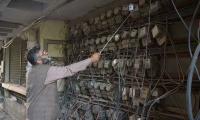LAHORE: Liquidity crunch and high cost of doing business are not the only concerns of the textile industry, but the main concern is the insistence of all major buyers to make products using efficient technology and a smaller carbon footprint.
Two decades back, social compliance was related to workers rights. That included minimum wage, overtime at double rate, clean, air and proper illumination, hygienic and sufficient number of toilets, subsidised meals, a clinic and day care centre for children, and healthcare.
Most of the textile exporters have achieved this compliance level. But many lack the compliance in sustainable production.
Exporters have to have a water treatment plant in their factory to dispose of water polluted with chemicals after proper treatment. Numerous small exporters lack this facility and are not on the radar of any large brand for placement of orders.
Most leading brands now insist that their buyers use cotton produced in Pakistan under the supervision of an NGO called Better Cotton Initiative (BCI). The farmers that cultivate cotton under the BCI supervision use less water, less fertiliser and less pesticides.
The carbon footprint of cotton produced under the umbrella of BCI is substantially less than cotton cultivated under conventional methods. Almost all the larger textile houses use BCI cotton that also is less polluted with foreign substances.
All the larger players and many medium sized exporters have also installed water treatment plant in their premises. Some textile exporters have gone beyond these requirements. For instance, some capture rain water in their vast premises for use in their processes.
Some have started reusing industrial water after treatment and recycling. There are some mills that are also recovering chemicals during the water treatment process. These chemicals are reused instead of buying fresh lots. All these procedures enhance their reputation among the large foreign brands that now prefer suppliers who care for the environment.
This is the reason that the orders for small less compliant exporters are diminishing. The SMEs are now getting orders from buyers that own no brand. Government and the SMEs should join hands to go a step ahead of social compliance to sustainable production for surviving in the global markets. The most expensive compliance in this regard is the installation of water treatment plant.
Most of the smaller exporters cannot afford it. Governments in our neighbouring economies have built a common water treatment plant that connects each exporting unit with it. The state or a private party then operates the facility and charges each factory according to the volume of effluent.
The foreign buyers would soon conduct energy audit of their Pakistani suppliers to ensure that they do not unnecessarily increase their carbon print through faulty installations or inefficient apparatus. Energy audit would drastically reduce the power use in smaller units that will also save cost.
We as a nation are against big businesses, but sometimes they are doing good for the country. In a first in the world, Nishat Dyeing and Finishing has developed a sustainable continuous apparel dyeing process, which besides saving chemicals, helps save energy including gas and electricity during continuous apparel piece dyeing.
Thus, less chemicals are thrown in the drainage system. It is the first company in the world to take a leap towards development of a process called PS2 in collaboration with a company named Rotaspray.
By dyeing the fabric through spray the company was able to save 35-40 percent power and gas (as less drying was required on dye sprayed on fabric than conventional method of immersing the fabric in liquid dye).
This has given the mill a huge advantage over its competitors in and outside Pakistan. We need to appreciate such incentives. Carbon footprint from conventional method of dyeing comes to 7,095 tons per annum per machine. From the PS2 method, the carbon footprint was reduced to 5,764 tons/year. Thus, the new process resulted in reducing the carbon footprint by 18.76 percent.
A trader works on the floor of the New York Stock Exchange , New York City. — AFP/FileNow that US interest rates...
A general view of al-Atba district of the Egyptian capital Cairo. — AFP/FileCAIRO: Egypt appears on track to break...
A man selling vegetables waits for customers at his makeshift stall at Empress Market in Karachi. — ...
A woman shops in a wet market in Kuala Lumpur, Malaysia. — Reuters/FileKUALA LUMPUR: Malaysia's economy grew faster...
The Pakistan Business Forum logo. — Facebook/pbf.limitedISLAMABAD: The Pakistan Business Forum on Saturday called...
US dollar banknotes are seen in this illustration taken March 10, 2023. — ReutersKARACHI: The government plans to...







